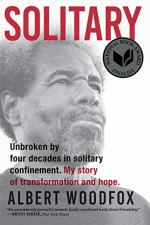|
This section contains 576 words (approx. 2 pages at 400 words per page) |

|
Solitary Summary & Study Guide Description
Solitary Summary & Study Guide includes comprehensive information and analysis to help you understand the book. This study guide contains the following sections:
This detailed literature summary also contains Topics for Discussion on Solitary by Albert Woodfox.
The following version of this book was used to create the guide: Woodfox, Albert. Solitary. Grove, 2019.
Albert Woodfox was born on February 19, 1947 in New Orleans. His biological father left his mother, 17, to raise Albert alone. His mother meets and marries James B. Mable. After Mable retires from the Navy, his demeanor changes and he becomes abusive towards Woodfox’s mother. She leaves with Albert and the children that she can and moves in with her brother’s family in New Orleans. Living in poverty, Woodfox shoplifts bread and canned goods to help feed the family. He continues these petty crimes throughout his teenage years. Arrested after a car chase, he is sent to city jail, escapes, and then is sent to Louisiana State Penitentiary at Angola. He serves his time, is paroled at 19, returns to the street, and is soon caught for armed robbery.
Woodfox again escapes from city jail and takes a bus to New York City. He is arrested and placed in the Manhattan House of detention. In this prison Woodfox meets members of the Black Panther Party and learns about institutionalized racism. This changes Woodfox’s view of himself, and kindles his life-long interest in social justice and activism. He participates in protests within the prison. After his prints catch up with him, he is sent back to Angola.
At Angola Woodfox meets Herman Wallace and they both establish a Black Panther movement at the prison. They become successful in reducing the sex slave business at Angola and in uniting prisoners towards better living conditions. In 1972 when a guard, Brent Miller, is murdered at the prison, four inmates are charged with the murder, including Wallace and Woodfox. Despite conflicting testimony and no physical evidence, Woodfox and Wallace are convicted of Miller’s murder and sent to solitary confinement (CCR) at Angola. CCR means prisoners are locked in their individual 6-foot by 9-foot cells for 23 hours a day. On the one hour they are allowed to be outside their cells, they can shower, walk up and down the hallway of the cellblock/tier or exercise in the outside CCR yard.
In CCR they meet another prisoner and fellow Black Panther member Robert King, build a friendship, and create protests to improve conditions at CCR, such as receiving contact visits or installation of food slots in the doors. Despite not being a threat and having good behavior, they remain on CCR. Through the decades in prison, both Wallace and Woodfox appeal their criminal conviction. Outside prison, other people are realizing that a grave miscarriage of justice has happened and work to help free them. One person working on their behalf is Leontine Rogers, Brent Miller’s wife at the time of his murder. Over the decades, Woodfox sees the ups and downs of new appeals, trials, and support. However, despite this, the outcome is the same, and Woodfox remains in prison, in CCR, for over four decades.
Woodfox misses an indescribable amount of personal events in his decades serving a sentence for a crime he did not commit, including not being able to attend his mother’s funeral. Woodfox remains behind bars into his late sixties. Before his third trial begins, his lawyers convince him to make a deal. In it, he is freed from prison, but the conviction stands. Woodfox gets freedom, but not justice. His memoir ends on his adjusting to life outside prison and his continued efforts for social justice.
Read more from the Study Guide
|
This section contains 576 words (approx. 2 pages at 400 words per page) |

|



